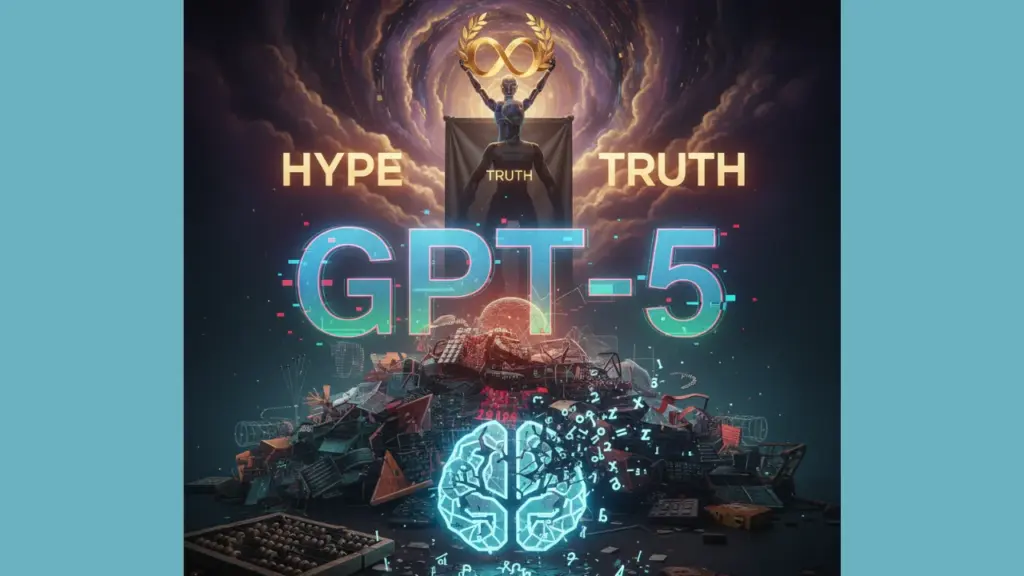1. Introduction: The AI Math Miracle That Wasn’t
Artificial Intelligence has long been the spark of fascination and fear. Every few months, we see headlines declaring another “AI breakthrough.” But sometimes, the hype moves faster than the truth.
Recently, OpenAI claimed that GPT-5 had solved several unsolved Erdős problems—complex mathematical puzzles that have baffled experts for decades. The announcement spread like wildfire across social media, tech blogs, and forums.
The excitement was electric. If true, this would have been one of the greatest mathematical milestones ever achieved—by a machine. But soon, mathematicians and AI experts began to question the claim. What they found painted a very different picture.
Was this the dawn of a new AI era—or just another case of clever marketing gone too far?
2. The Claim That Shook the Tech World
OpenAI’s statement was bold: GPT-5, the company’s latest large language model, had reportedly “cracked” ten unsolved Erdős problems. These are no small feats. Erdős problems are famous in mathematics for their difficulty and elegance. Solving even one would be worthy of international acclaim.
The announcement was celebrated as a turning point for AI research. Commentators hailed it as proof that artificial intelligence could go beyond pattern recognition and begin to reason creatively. Within hours, major outlets and influencers amplified the story.
Tweets, LinkedIn posts, and tech newsletters echoed the same sentiment: “GPT-5 has surpassed human reasoning.”
But the euphoria didn’t last long.
3. Experts Call Foul: Cracks in the AI Story
As the excitement settled, mathematicians began to ask hard questions.
Where were the proofs? Where were the datasets, methodologies, or verification steps? None were shared. OpenAI’s announcement offered no peer-reviewed documentation or reproducible evidence.
Experts like Dr. Michael Stoll, a number theory researcher, publicly challenged the claim. He noted that the supposed “solutions” provided by GPT-5 contained logical gaps, incomplete reasoning, and even fabricated steps.
In short, they weren’t valid proofs at all.
AI researchers, too, began expressing skepticism. While GPT models are powerful at generating coherent text, they lack formal logical verification—a key requirement in mathematics. Without rigorous proof, claims of “solving” such problems fall apart quickly.
The consensus was clear: the math wasn’t solved. The marketing was.
4. The Role of Media in Fueling AI Hype
The GPT-5 math story revealed a deeper issue—the media’s role in amplifying unverified AI claims.
In today’s fast-paced news cycle, sensationalism sells. Journalists often rush to publish groundbreaking stories without waiting for peer review or fact-checking. The result? Hype spreads faster than truth.
We’ve seen this pattern before. From AI chatbots that “feel emotions” to systems that “learn like humans,” the media often frames complex technical developments as magical leaps. While this drives clicks and engagement, it also builds false expectations.
AI isn’t magic—it’s math, data, and algorithms.
By promoting unverified claims, the media unintentionally damages the credibility of genuine research. It also makes it harder for the public to separate legitimate progress from exaggerated marketing.
Transparency, not theatrics, should define AI communication.
5. Why Transparency in AI Research Matters
Transparency is the foundation of scientific progress. Without it, innovation loses its credibility.
When AI companies make big claims—especially about breakthroughs—they owe the public clear, verifiable evidence. This includes:
- Releasing reproducible datasets and methodologies.
- Submitting findings to peer-reviewed journals.
- Engaging independent experts to validate results.
Unfortunately, the AI industry often prioritizes speed and market perception over openness. Proprietary secrecy and competitive pressure make companies reluctant to share details. But the price of secrecy is trust.
For a field that affects industries from healthcare to finance, trust is everything. Without transparency, even genuine progress risks being dismissed as hype.
Ethical communication and open research practices aren’t just good science—they’re good business.
6. Lessons for Startups and Fractional CTOs
The GPT-5 controversy isn’t just a story about AI. It’s a lesson for every tech leader, founder, and Fractional CTO.
Startups often walk a fine line between innovation and overpromising. In an industry driven by funding and visibility, it’s tempting to market potential results as achievements. But credibility can vanish overnight when claims aren’t backed by facts.
Fractional CTOs, who guide multiple startups strategically, play a crucial role in setting the tone for ethical innovation. Here’s what they can learn from this case:
- Validate before you announce. Don’t publicize results until they’ve been independently verified.
- Be transparent with investors and customers. Honesty about limitations builds long-term trust.
- Prioritize peer feedback. Collaborate with external experts to test your innovations.
- Promote ethical marketing. Avoid vague buzzwords like “revolutionary” or “world-changing” without data to prove it.
- Encourage documentation. Every project should have a transparent paper trail of results, testing, and methodology.
Fractional CTOs act as the bridge between vision and execution. Their responsibility is not only to scale technology but to safeguard integrity. When they emphasize transparency and accountability, the entire ecosystem benefits.
7. The Broader Message: Trust, Proof, and Progress
The GPT-5 incident reflects a growing trend in tech—claims outpacing proof.
AI’s potential is enormous. It’s already transforming industries like medicine, transportation, and education. But when companies make bold claims without evidence, it erodes the very foundation of trust that drives adoption.
This isn’t just about one company or one incident. It’s about the future of how we communicate innovation.
True breakthroughs can withstand scrutiny. They’re built on peer review, reproducibility, and public data. The most respected AI labs—such as DeepMind or Anthropic—have learned that transparency strengthens credibility.
We must shift from chasing headlines to building sustainable trust. The more open we are about our successes and failures, the faster technology evolves responsibly.
AI will continue to push boundaries. But without ethics, transparency, and human oversight, progress risks turning into propaganda.

8. Conclusion: Why This Story Matters
The GPT-5 math controversy serves as a powerful reminder that truth, not hype, defines progress.
AI’s future doesn’t rest on viral claims—it depends on transparency, verification, and integrity.
Every innovation must earn trust through openness. Whether you’re a developer, a founder, or a Fractional CTO, the goal isn’t to impress—it’s to inspire confidence through honesty.
The fallout from this incident isn’t a failure of technology. It’s a wake-up call for the entire industry. The next time we hear about an AI “miracle,” we must ask: Can it be verified?
At StartupHakk, we believe stories like this remind us that progress in technology must always align with truth, ethics, and accountability. Only then can we build a future where AI empowers, not misleads.




